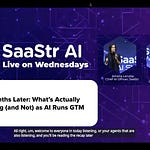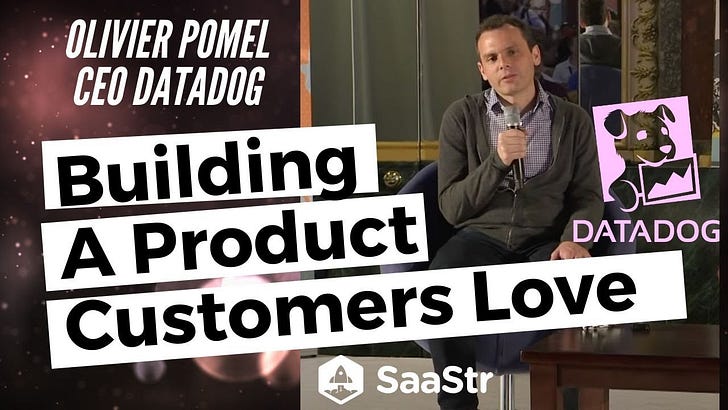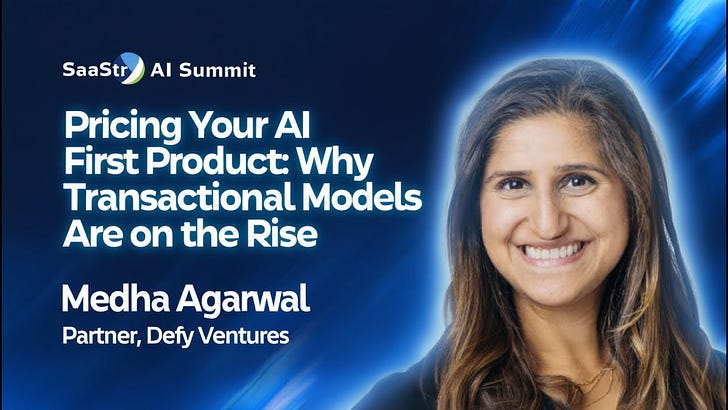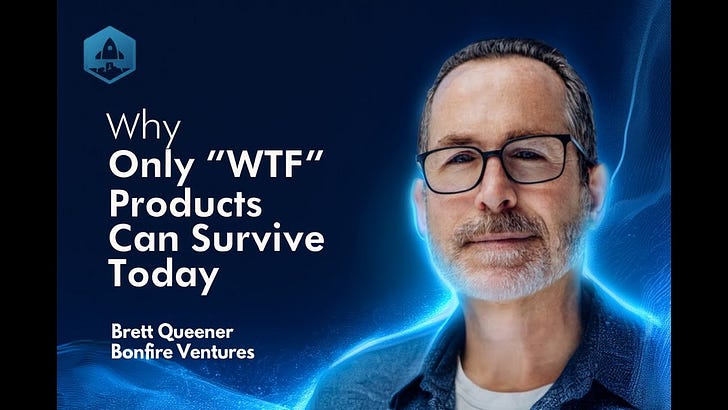The HubSpot AI Playbook: How Yamini Rangan Is Leading the Most Aggressive B2B AI Transformation
HubSpot's CEO came to SaaStr + AI Summit to do a deep and honest dive on how she's transforming the company into an AI-first $2.75B+ ARR B2B leader. And what it means for the future of B2B software.
The January 2023 Pivot That Changed Everything
HubSpot had spent four months meticulously planning your 2023 roadmap. Every feature mapped out, every sprint planned, every resource allocated. Then ChatGPT happens in November 2022, and by January 2023, you make a decision that would reshape your entire company.
"We came into January 2023 and we said, pivot," HubSpot CEO Yamini Rangan told the SaaStr audience. "That entire roadmap that we just planned for the last three to four months is not going to be what we are building in 2023."
This wasn't a gradual shift or a cautious experiment. This was a complete organizational bet on AI that would see HubSpot ship their first AI features by March 2023 – just two months after the pivot decision.
The result? HubSpot now has 95% of their engineering team using AI tools daily, customers seeing 70-80% ticket resolution rates with AI agents, and a fundamental reimagining of what B2B software can be.
The "Kid in the Candy Store" Test
Before diving into the tactical details, Rangan shared what might be the most important hiring and team-building insight for the AI era:
"If they're not saying this is the kid in the candy store age, you have the wrong team. They should be excited. They should be going home at night and screwing around and coming up. They should be doing internal hackathons, even though you haven't had one in five years."
This isn't just about enthusiasm – it's about recognizing that the last five years of B2B software development were, in Rangan's words, "boring." The same playbooks, the same incremental improvements, the same compliance features.
"If you're not seeing that [excitement], it's brutal, but you got the wrong team," she emphasized.
The Two AI Use Cases That Actually Work
While the industry debates AI's potential, Rangan is clear about what's already proven: "Coding and support – these two use cases have found product market fit with AI. No question. We're not going back."
Support: The 70-80% Resolution Reality
HubSpot's internal support AI now resolves 45% of tickets, but their customers using HubSpot's customer agent are seeing even better results:
Average 52% resolution rate across 2,500+ customers
Top performers hitting 70-80% resolution rates
The difference? Knowledge base quality and completeness
"It comes down to knowledge and knowledge-based articles," Rangan explained. The companies seeing 80% resolution rates versus 40% have invested in comprehensive documentation and knowledge bases.
The setup time? "A few hours" if you have your knowledge base, support history, website data, and community answers ready to sync.
Coding: The 95% Daily Usage Revolution
Within HubSpot's engineering organization, 95% of developers use AI-powered code generation daily. The impact goes beyond just faster coding:
"We have to be even more careful about what we ship. It's not just the velocity of shipping something as new features. It is what is the value."
This abundance of development capacity is forcing a fundamental shift from feature velocity to value measurement – a change that's rippling through their entire product strategy.
The Death of Volume-Based Go-to-Market
One of the most striking insights from Rangan was how AI is forcing a complete rethink of traditional B2B sales metrics:
"We've gotten used to in the old playbook, increase the volume of leads, increase the amount of pipeline, increase everything. And it's been this focus on volume. It really needs to be focused on conversion because the volume is exploding."
The old playbook is dead. Rangan shared a perfect example – receiving an SDR email that morning asking to meet "next week" at SaaStr. The conference was happening that week.
"That is egregious," she said. "If you have like egregiously wrong information, like 'Oh, your conference is next week,' then you're out."
Personal vs. Personalized: The New Standard
The shift isn't just from volume to quality – it's from personalized to personal.
"We've been talking about personalization for a very long time, which is you segment your customers, you take your customers and you personalize your data and send it to everybody in that segment. That doesn't cut it anymore. It needs to be personal."
Personal means: "Jason, here are the four posts that you did. Here is why I can help you with this single problem that you have. And let me get 10 minutes with you."
Rangan recently received two personal videos from salespeople referencing specific points from HubSpot's earnings call two weeks prior and how they could specifically help. "That caught my attention."
The Handoff Problem: Where AI Breaks Down
Even as AI improves the first touch, Rangan identified a critical weak point: the handoff to humans.
She shared Jason's story of a perfect AI-generated first email that won a deal immediately, followed by a terrible human follow-up asking basic questions already answered in the prospect's public information.
"The AI was so good. Yeah. But not a great handoff."
This points to a larger challenge: as AI capabilities improve, the human elements need to get dramatically better, not just maintain current standards.
The Platform Thesis: Why Point Solutions Will Lose
Rangan's boldest prediction centers on why integrated platforms will dominate in the AI era:
"Point agents will not win in this whole race that we are in."
The reasoning? Agent onboarding mirrors employee onboarding:
"When your employee joins your company, what do you do in the first week for that employee? You provide your products, your ideal customer profile, your brand voice, your tone, your competitive differentiation, your value proposition. You actually train your employee with all of that context so that the employee can contribute meaningfully to your organization. That's the same thing that's happening with agents."
Companies with unified data across the entire customer journey can train agents more effectively than point solutions with limited context.
The Blurring Lines: From Specialists to Generalists
HubSpot's customer agent, originally built for support, is being used for pricing questions, event information, and sales inquiries. This isn't a bug – it's the future.
"The lines are blurring. And at the end of the day, you serve your customer. Your customer does not need to know which org they're dealing with."
This extends beyond customer-facing functions. AI is enabling generalists across the organization:
"In marketing, you might not be the translation expert, but you can now translate. You might not be the video editing expert, but you can edit your videos right now. You might not be specified like social channel media expert, but AI is going to help you do that."
The implication? The specialist-focused tool category that has dominated B2B software may be giving way to generalist-enabling platforms.
The Search Paradigm Shift: From Click to Conversation
Perhaps the most fundamental shift Rangan identified is the death of the traditional web interaction model:
"Search is gone. Like we're not just searching to get the information anymore. AI overviews are actually providing answers. So waiting for search to lead traffic to your website is gone."
The new pattern isn't "search, click, and consume" – it's "ask a question and get an answer."
"You're not pointing, clicking, searching, consuming. You're just asking a question in your natural language and getting an answer."
This means every company needs an AI agent, not just a website. Static websites are becoming conversation carriers.
The Partner Moat: 40% Revenue, 100% Loyalty
While everyone focuses on AI, Rangan reminded the audience about a more traditional but powerful moat: partners drive 40% of HubSpot's ARR, and 70% of their partners focus exclusively on HubSpot.
"How many of them sell 11 other competitors? None."
This partner exclusivity creates a powerful moat. When customers work with HubSpot partners, they're not evaluating multiple vendors – they're getting HubSpot.
The lesson for founders: "Study your ecosystem. If your ecosystem is in any way partner-driven, and you'll see if you go super, if you go into security or enterprise, sometimes it's 100%. Wiz is all partners. You want to compete with Wiz and you want to sell direct, you're just gonna lose."
The Curiosity and Growth Mindset Filter
When asked who will "make the cut" in the AI transition, Rangan's answer was simple: "Curiosity and growth mindset."
"If you're trying to slow roll AI, if you think that this is going to go away, if you're not investing in yourself and developing a level of AI fluency, then you've pretty much lost the game."
This isn't just about technical skills – it's about embracing change as a constant. As Rangan put it: "Change has been the constant. And you just have to thrive in it."
The Neat vs. Necessary Framework
HubSpot obsessively tracks AI usage patterns, focusing on what Rangan calls the "neat vs. necessary" distinction:
"There are novel, neat AI things. We've all used it in our personal life. We've used it once and it has this beautiful image that it creates and then we never go back to it. That's just neat. But AI has to be necessary."
The key metrics they track:
Daily repeat usage vs. weekly repeat usage vs. novelty use
What are users clicking on?
Which features drive consistent value vs. one-time "wow" moments
"AI has to go from just being neat to being necessary, to being in the flow of everyday work in order to have the promised transformative benefits."
What This Means for Your Business
The HubSpot playbook offers several concrete takeaways:
1. Embrace the Pivot Mentality Be ready to completely reshape your roadmap when the market shifts. The companies that win won't be the ones with the best 2024 plans – they'll be the ones that can completely reinvent their 2025 plans.
2. Start with Proven Use Cases Don't try to be creative with AI applications. Start with coding and support where product-market fit is proven, then expand from there.
3. Measure Value, Not Velocity As AI increases your ability to ship features, become more selective about what creates actual customer value.
4. Invest in Platform Thinking Point solutions will struggle in an AI world. Think about how to provide comprehensive context and data to AI systems.
5. Prepare for the Personal Standard Volume-based outreach is dead. Invest in AI tools that enable truly personal, contextual outreach at scale.
6. Design for Conversation Your website and customer interfaces need to enable natural language conversation, not just navigation and consumption.
The Bottom Line
HubSpot's AI transformation isn't just a product story – it's a complete reimagining of how B2B software companies operate, sell, and serve customers. Under Rangan's leadership, they've made the bold bet that AI isn't just a feature enhancement but a fundamental shift requiring new playbooks across every function.
The companies that recognize this shift and act decisively, like HubSpot did in January 2023, will define the next era of B2B software. Those that don't may find themselves with beautiful roadmaps for a world that no longer exists.
As Rangan put it: "Change has been the constant. And you just have to thrive in it."
The question isn't whether AI will transform your business – it's whether you'll lead that transformation or be disrupted by it.









